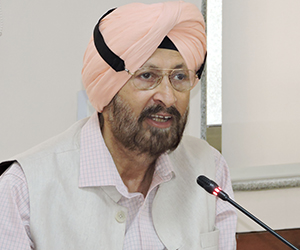As had been widely anticipated, President Xi Jinping consolidated his position as the undisputed “core” leader of China at the 19th National Congress of the Communist Party of China held at Beijing in the third week of October 2017. Xi was also re-elected to all three posts that he has been holding for almost five years since the 18th National Congress: President of China, General Secretary of the Communist Party of China and the Chairman of the Central Military Commission (CMC).
In a move that placed him on the same pedestal as Mao Zedong and Deng Xiaoping, the National Congress unanimously passed an amendment to the party’s constitution to include “Xi Jinping Thought on Socialism with Chinese Characteristics for a New Era” in the party’s constitution as one of its guiding principles.
Xi’s “Belt and Road Initiative”, an ambitious infrastructure development programme designed to link China with its regional neighbours and beyond was also included in the party constitution. Xi ensured that only his protégés and those personally loyal to him were elected to the seven-member Standing Committee of the Politburo, China’s most powerful governing council.
Report Card
Reading out his report card at the marathon opening session of the National Congress, Xi presented China as an indispensable force in countering global economic sluggishness. He said China had contributed significantly to dealing with international peacekeeping, regulating global economic governance, reshaping multilateral institutions, spurring global efforts to fight climate change, enhancing energy security and improving global health. He made no mention of the instability caused by Chinese military assertiveness in the East and South China Seas and by the blatant disregard of a rules-based international order.
The princeling son of a revolutionary leader, Xi is the first civilian chairman of the CMC and presides over a 2.3 million-strong PLA, the world's largest armed forces. The 19th National Congress was utilised by Xi Jinping, who is also the Commander-in-Chief, to demonstrate his complete control over the People’s Liberation Army (PLA). One of the key stratagems that facilitated his rise to the position of undisputed numero uno was his carefully choreographed plan to gain control over the PLA.
Xi realised this goal through military reforms, the promotion of loyalists and the removal of Generals who did not happily toe the line. He launched a ruthless drive against corruption and had a large number of officers of the rank of Major General arrested. It has been reported that by March 2017, approximately 5,000 officers had been punished for graft; many other senior officers were forcibly retired.
Military Reforms and Strategic Outreach
Large-scale military reforms were initiated by Xi Jinping to make the PLA a more modern force that can preserve China’s territorial integrity and project power in China’s area of strategic interest to extend China’s strategic outreach through increased military presence overseas, especially in the Indo-Pacific region.
Sweeping reforms of the military to enhance combat readiness and operational efficiency included the cutting of troop levels by 300,000 personnel. Reforms have led to the disbandment of the four ‘traditional’ General Departments (General Staff, Political, Logistics and Equipment) and the establishment of 15 new departments all of which have been placed directly under the CMC. Under these 15 departments will be 84 restructured corps-level ‘units’.
These units include the provincial military commands, military academies and universities that come directly under the Ministry of Defence. They also include the headquarters of the PLA Army, Navy, Air Force, Rocket Force (erstwhile Second Artillery) and the newly constituted Strategic Support Force. The seven existing Military Regions have been dismantled and five ‘outward looking’ joint theatre commands have been established. Five group armies (corps-level formations) have also been disbanded, leaving 13 still standing.
The PLA Navy is getting the maximum attention in the military modernisation drive energised by Xi Jinping. launched its first aircraft carrier in April 2017; in June it introduced Asia’s most advanced guided missile destroyer; it is developing cutting-edge propulsion technology; and, is building large amphibious assault vessels.
Demanding the PLA’s Loyalty
Officially, the PLA is the armed wing of the Communist Party and Xi Jinping has often reminded the PLA leadership of this fact. In April 2017, Xi Jinping demanded that all military units should be absolutely loyal to the Communist Party. In August 2017, Xi asserted, “You shall be unswervingly loyal to the absolute leadership that the party has over the army, heed the call of the party, follow the party.”
At the 19th National Congress, Xi again asked the PLA to be absolutely loyal to the ruling Communist Party. He set two goals for the PLA: to become a modern fighting force by 2035 and to then graduate to the world’s best military force by 2050; and, intensify its combat readiness by focusing on how to win wars. The message to India is clear: expect more transgressions of the Doklam variety.
With the support of the Party and the PLA, President Xi Jinping plans to continue his pursuit of the “Chinese Dream” – an inspirational slogan coined by him to reflect the people’s aspiration for a rejuvenation of the Chinese nation. However, the unfettered realisation of the Chinese Dream will be possible only in a peaceful and stable environment. In order to promote a regional security environment conducive to socio-economic development, China will have to tone down its military assertiveness and confrontational attitude and graduate to cooperation and respect for a rules-based international order.
(The writer is Distinguished Fellow, Institute for Defence Studies and Analyses (IDSA), New Delhi)
(Views expressed are of the author and do not necessarily reflect the views of the VIF.)
Image Source: https://eastisread.wordpress.com/2015/02/13/chinese-dreams-and-the-african-renaissance/











Post new comment